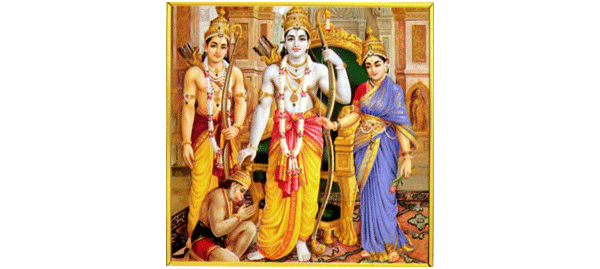The Role Models from Ramayana
Contributed by RP Turaga

Om Tat Sat

I bow to that Lord Raghunandana (Sri Rama),
on whose right side is Lakshmana,
on the left side is His consort Sita, daughter of Janaka,
and Maruti (Sri Hanuman) is in the front.
------------------
The Ramayana teaches the values of life and also demonstrates the ways to uphold them.
The Ramayana offers us guidance on proper conduct and observances through Sri Rama and Mother Sita.
Sri Rama and Mother Sita lead by example.
The Ramayana has been a continuous source of inspiration and guidance to Society for many centuries.
The ethical & moral teachings of Ramayana are meant for all sections of society: common man, scholar, spiritual seeker.
The Ramayana is a product of the penance and deep meditation, practiced by it's author Valmiki throughout his life.
Valmiki's Ramayana consists of 24,000 shlokas (verses), divided in to seven kandas (parts), and 500 sargas (chapters):
1. Bala Kanda
2. Ayodhya Kanda
3. Aranya Kanda
4. Kishkinda Kanda
5. Sundara Kanda
6. Yuddha Kanda
7. Uttara Kanda (Appendix)
In the Ramayana the reader experiences both entertainment and enlightenment.
Ramayana is a literary master piece composed by a master mind namely Valmiki.
The Mission of Ramayana is Man Making and Character building. In order achieve this mission, the Ramayana provides us with Role Models.
Valmiki proclaims the greatness of various vIrtues through many a character in the Ramayana.
Sri Rama, Sita, Lakshmana, Bharata, Hanuman are some of the remarkable exemplars.
Hanuman is presented as the best example of self effacement, courage, strength and devoted service to his ideal master, Sri Rama.
The Role Models inspire us to develop the Divine Qualities, practiced and demonstrated by the role models in their day-to-day life.
Their lives and teachings are a source of strength and inspiration for entire humanity, in meeting the day-to-day challenges of human life.
We begin the study of the Ramayana Role Models, with Sri Rama, son of King Dasharatha.
He is a paragon of all qualities ever conceived by the imperfect human mind.
The name of Sri Rama is closely associated with Dharma (Righteouness) through out his life in all his thoughts, words and deeds.
Dharma (righteousness) begins to wane through the passage of the Yugas.
It is believed that there is a decline in ethical values in the four Yugas that follow in succession — Krita, Treta, Dwapara and Kali.
While it was very strong in the Krita and Treta Yugas, the decline began during the Dvapara Yuga and in Kali Yuga its weakening effects are prominent.
That the Ramayana, which belongs to the Treta Yuga, continues its hold even today is testimony to the eternal values that Lord Rama represents.
It is said that during Rama Avatar, when the Lord incarnated, the Vedas descended as the Ramayana.
The Lord appears on this Earth when dharma is under threat and Mother Earth’s burden becomes unbearable.
This text becomes the most authentic source of reference regarding righteous living because Lord Rama upheld the best and the highest Dharma, exemplifying human values that govern an individual in his relation to family and society.
Ramayana is a beautiful poetical presentation of the sublimity of these two virtues Satya and Dharma, with Rama, the embodiment of these virtues forming the central character of the Kavya (poem).
Dharma (Righteousness) is the watchword in the Ramayana.
The Ramayana is anchored in Dharma.
Om tat Sat
Referencee : http://valmiki.iitk.ac.in/index.php?id=sloka1
Reference: http://www.kamakoti.org/hindudharma/part1/chap1.htm




